by Marjorie Moore | Nov 5, 2013
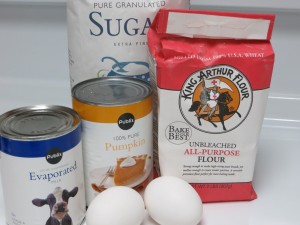
Store homemade pumpkin pies in the refrigerator.
To refrigerate pumpkin pies or not to refrigerate? That is the question. You have seen pumpkin pies in the bakery section of supermarkets not refrigerated and you wonder if you can do the same at home. Unfortunately, homemade pumpkin pies need special care to prevent foodborne illness. Pumpkin pies are a custard-style pie made by using potentially hazardous foods such as eggs and milk. Food temperature controls are especially important with foods classified as potentially hazardous.
Pumpkin pies also have a high moisture and protein content. They must be kept at a refrigerated temperature of 41° F or cooler. If the pies are left out of the refrigerator for more than 2 hours, bacteria grows more rapidly and can cause a foodborne illness.
When cooking, make sure to test your pies for doneness by inserting a clean knife in the center. The knife should come out clean. Remove the pies from the oven and allow them to cool at room temperature for about 30 minutes. After they have cooled, cover and refrigerate to keep them cold.
So, why are pumpkin pies displayed at room temperature at the supermarket? These pies are formulated with shelf-stable ingredients, such as preservatives, that prevent harmful bacteria from growing. Commercial pies must be properly labeled, “approved by the Food and Drug Administration”. They will carry the letters “RT”, which means they meet the guidelines required for display at room temperature. The label will also give a “sell by” or “use by” date. Even these pies should be refrigerated for storage at home especially after they have been cut.
Additional pie safety tips include making sure you purchase clean, refrigerated and uncracked eggs. Keep hands clean by washing them with warm water and soap before handling ingredients. Also, wash utensils, equipment and work surface area with hot soapy water before and after contact with eggs. Never leave milk or eggs out of the refrigerator for more than two hours.
Enjoy those traditional holiday feasts, but keep them safe!
by Ricki McWilliams | Oct 30, 2013
 Last year, the Consumer Federation of America (CFA) and the Credit Union National Association (CUNA) found that 12 percent of people said they were planning to spend more during the holidays than in the previous year. That number was up from 2011, where only 8 percent planned on spending more than in the previous year. This year, help reverse this trend and plan on spending less and saving more. Remember, it’s the thought that counts, not the amount you spend. Helpful tips for spending less and saving more:
Last year, the Consumer Federation of America (CFA) and the Credit Union National Association (CUNA) found that 12 percent of people said they were planning to spend more during the holidays than in the previous year. That number was up from 2011, where only 8 percent planned on spending more than in the previous year. This year, help reverse this trend and plan on spending less and saving more. Remember, it’s the thought that counts, not the amount you spend. Helpful tips for spending less and saving more:
- Make a Budget and a List: Decide how much you can afford to spend and stay within that budget. Make a price list of all gifts and other holiday items you plan to purchase. Take the list with you shopping to avoid overspending and impulse buys.
- Comparison Shop: You can easily save more than 10 percent on most items, sometimes considerably more, by comparing prices at different stores. The Internet and smart phones have made comparison shopping that much easier. But when shopping online, shop wisely. Be sure you are purchasing from a secure site and review emailed statements for accuracy as you receive them.
- Make Time Your Ally: The reason to start sooner rather than later is that when you delay, you pay. At the last minute, you have to settle for something, and it might cost more than you had wanted or planned to pay. Another benefit to starting early: It gives you more time to find the “right” gift and avoid impulsive decisions, which too often leave you less happy with your purchase.
- See what’s in your supply drawer: You may have more wrapping paper, ribbons, unused cards, and gift boxes stored away from last season than you realize. Use up those holiday supplies first to trim down the amount you’ll have to buy this season.
- Find Some Low- or No-Cost Ways to Celebrate: Adding a few changes can ease the strain on your spending budget. For example, draw names to reduce the number of people you have to purchase gifts for; give homemade items; make your own gift wrap; or organize a potluck rather than trying to make, and pay for, the entire holiday meal yourself.
With the money you save on gifts, you can give yourself the gift of financial freedom by paying down debt or building your emergency savings fund.
Need help finding ways to save? Take the America Saves pledge to make a commitment to yourself to save and to receive emails and/or text messages to keep you motivated. (America Saves, managed by the Consumer Federation of America (CFA), is a non-profit research‐based social marketing campaign that seeks to motivate, support, and encourage low- to moderate-income households to save money and build wealth. Learn more at americasaves.org.
Source: Katie Bryan, America Saves Communications Director
Additional ways to make a difference in YOUR financial future:
FREE ON-LINE CLASSES: Participate from your office, home, or web-enabled device. It is easy! Visit the registration link to reserve your spot. Then log on the day of the webinar to participate. All webinars are scheduled 11:30am – 12:30pm (CST).
• Credit Use and PowerPay Debt Reduction Tool – October 30
This webinar will cover strategies for wise credit use, factors that impact credit scores, and methods to pay off debt using a free, self-directed debt reduction program called PowerPay. Registration link: http://bit.ly/PowerPayToday
• The Cost of False Health & Nutrition Promises – November 1
This webinar will cover some of the myths and misleading claims that induce consumers to spend time and money on health products & supplements that have not had enough scientific scrutiny. Registration link: http://bit.ly/FHCCost
• 5 Simple Steps to Seasonal Savings – November 13
This webinar will cover seasonal stressors, developing a holiday spending plan, alternatives to pricey gifts, and fine-tuning your financial plan for the holidays. Registration link: http://bit.ly/ssss2103
To view archived webinars, please click here.
by Judy Corbus | Oct 25, 2013
Normal
0
false
false
false
EN-US
X-NONE
X-NONE
/* Style Definitions */
table.MsoNormalTable
{mso-style-name:”Table Normal”;
mso-tstyle-rowband-size:0;
mso-tstyle-colband-size:0;
mso-style-noshow:yes;
mso-style-priority:99;
mso-style-parent:””;
mso-padding-alt:0in 5.4pt 0in 5.4pt;
mso-para-margin-top:0in;
mso-para-margin-right:0in;
mso-para-margin-bottom:10.0pt;
mso-para-margin-left:0in;
line-height:115%;
mso-pagination:widow-orphan;
font-size:11.0pt;
font-family:”Calibri”,”sans-serif”;
mso-ascii-font-family:Calibri;
mso-ascii-theme-font:minor-latin;
mso-hansi-font-family:Calibri;
mso-hansi-theme-font:minor-latin;}
Normal
0
false
false
false
EN-US
X-NONE
X-NONE
/* Style Definitions */
table.MsoNormalTable
{mso-style-name:”Table Normal”;
mso-tstyle-rowband-size:0;
mso-tstyle-colband-size:0;
mso-style-noshow:yes;
mso-style-priority:99;
mso-style-parent:””;
mso-padding-alt:0in 5.4pt 0in 5.4pt;
mso-para-margin-top:0in;
mso-para-margin-right:0in;
mso-para-margin-bottom:8.0pt;
mso-para-margin-left:0in;
line-height:107%;
mso-pagination:widow-orphan;
font-size:11.0pt;
font-family:”Calibri”,”sans-serif”;
mso-ascii-font-family:Calibri;
mso-ascii-theme-font:minor-latin;
mso-hansi-font-family:Calibri;
mso-hansi-theme-font:minor-latin;}
Normal
0
false
false
false
EN-US
X-NONE
X-NONE
/* Style Definitions */
table.MsoNormalTable
{mso-style-name:”Table Normal”;
mso-tstyle-rowband-size:0;
mso-tstyle-colband-size:0;
mso-style-noshow:yes;
mso-style-priority:99;
mso-style-parent:””;
mso-padding-alt:0in 5.4pt 0in 5.4pt;
mso-para-margin-top:0in;
mso-para-margin-right:0in;
mso-para-margin-bottom:8.0pt;
mso-para-margin-left:0in;
line-height:107%;
mso-pagination:widow-orphan;
font-size:11.0pt;
font-family:”Calibri”,”sans-serif”;
mso-ascii-font-family:Calibri;
mso-ascii-theme-font:minor-latin;
mso-hansi-font-family:Calibri;
mso-hansi-theme-font:minor-latin;}
Normal
0
false
false
false
EN-US
X-NONE
X-NONE
/* Style Definitions */
table.MsoNormalTable
{mso-style-name:”Table Normal”;
mso-tstyle-rowband-size:0;
mso-tstyle-colband-size:0;
mso-style-noshow:yes;
mso-style-priority:99;
mso-style-parent:””;
mso-padding-alt:0in 5.4pt 0in 5.4pt;
mso-para-margin-top:0in;
mso-para-margin-right:0in;
mso-para-margin-bottom:8.0pt;
mso-para-margin-left:0in;
line-height:107%;
mso-pagination:widow-orphan;
font-size:11.0pt;
font-family:”Calibri”,”sans-serif”;
mso-ascii-font-family:Calibri;
mso-ascii-theme-font:minor-latin;
mso-hansi-font-family:Calibri;
mso-hansi-theme-font:minor-latin;}
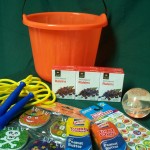
Give nutritious, tasty foods and non-food items for Fall treats.
With Halloween and Fall Festivals just around the corner, what goodies are you planning to give out? Try nutritious, tasty foods and non-food options, including items that get children up and moving to use the extra calories they consume. Think outside the box when choosing treats for trick-or-treaters or party-goers. The calories in all those bite-size Halloween treats add up quickly. Four “bite size” chocolate bars contain approximately 320 calories, 25 jelly beans have 140 calories, and 20 pieces of candy corn add up to 100 calories.
There are other treats that are lower in fat and sugar and may provide vitamins, minerals, and fiber. Set a good example by passing out healthy treats like these instead of candy:
- cereal bars
- snack packets of dried fruit, baked pretzels, nut and seeds (e.g. peanuts*, unsalted almonds, sunflower seeds or pumpkin seeds)
- trail mix*
- packages of low-fat crackers with cheese or peanut* butter filling
- animal crackers
- goldfish-type crackers
- graham crackers
- 100-calorie packs of various products
- beef or turkey jerky
- single-serve boxes of ready-to-eat cereal
- mini boxes of raisins and chocolate-covered raisins
- fig cookies
- sugar-free gum or hard candy
- gummy candies made with real juice
- individual juice drinks (100% juice)
- pudding cups
- gelatin cups with fruit
- applesauce cups
- single-serve packets of low-fat microwave popcorn
- sugar-free hot chocolate or apple cider packets
*Be careful of peanut and tree nut allergies.
If you choose candy for treats, look for those that are lower in fat and sugar. Choose bite-size candy bars based on the least amount of fat and calories per serving. In addition, consider healthier dark chocolate versions.
Non-food Treats: Children also will enjoy non-food treats** like those typically given in birthday goodie bags:
- small toys and pocket-sized games
- glow sticks
- costume jewelry (plastic rings, necklaces, and bracelets)
- funny Halloween glasses
- false teeth
- miniature magnifying glasses
- tiny decks of cards
- small stuffed animals
- pencils
- pencil toppers and fancy erasers
- markers
- stickers, including reflective safety stickers
- rub-on or stick-on temporary tattoos
- bookmarks
- crayons
- coloring tablets
- paint brushes
- pages from coloring books
- children’s magazines or comic books
- bottles of bubbles
- coins (pennies, nickels, dimes)
- fake money
- whistles
- toothbrushes
- used books
- coupons from a yogurt store or juice bar
**Some treats fit all ages, but small items should be limited to kids over age three.
Treats to Promote Activity: Encourage kids to be more physically active by giving small, inexpensive toys to get them up and moving.
- a bouncy ball
- a jump rope
- sidewalk chalk for drawing a hopscotch or foursquare game
- a beanbag for hacky sack
- a plastic or foam flier
Inspect all Halloween treats before children eat them. When in doubt, throw it out! Inventory your children’s candy, and don’t let them eat too many treats at once. Let kids choose a few pieces of candy to eat on Halloween night and then eat a few pieces each day after that.
Combine a treat, such as a miniature candy bar, with a healthy snack like an apple. Make sure the child eats the apple first so they are less hungry for the treat. This provides them with the health benefits of the apple while teaching them healthier eating habits.
Most candy has a long shelf-life. Put the “treat stash” out of children’s reach and limit them to eating about two pieces of candy a day. Larger treats, such as chocolate candy bars, can be cut into smaller pieces and frozen. Pull them out weeks or months later for some bite-sized treats.
Kids with diabetes can have a few sweet treats, too. The rule is moderation with foods high in carbohydrate, including sweets and starches. Suggest the child choose a few favorite treats and trade in the rest for money or a present.
Show children how much you care about them. Give them treats that help them choose wisely today and begin a lifetime of healthy habits.
Source: Healthy Halloween Treats, Clemson University Cooperative Extension, http://www.clemson.edu/extension/hgic/food/nutrition/nutrition/life_stages/hgic4112.html.
by Angela Hinkle | Sep 30, 2013
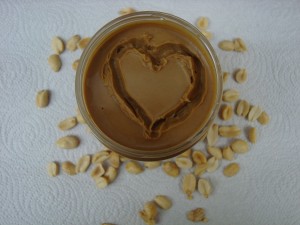
Nutty for Peanut Butter
Peanut butter is a versatile food which has soared beyond being jelly’s side kick on bread. Peanut butter can be used as a snack, as part of a full meal, in baking, and yes, even in cooking. It’s an economical source of protein and it is a wonderful food to pack on the go because it won’t spoil as quickly as most animal proteins will.
Even though most people think of them as nuts, the peanuts which are ground up to make peanut butter, are part of the legume family. Peanut butter is packed with heart-protecting mono and polyunsaturated fats – which are the “good”, cholesterol lowering fats. Also the ratio of saturated fats to unsaturated fats puts peanut butter right up there with olive oil. Do keep in mind, however, that these fats are also what make peanut butter a high calorie food. Like other yummy foods, moderation is key so try to limit yourself to about 2 tablespoons – about 180 calories.
Peanut butter is a good source of protein, and essential vitamins and minerals which include Vitamin E, niacin, and magnesium. On average, 2 tablespoons of peanut butter has about 8 grams of protein which helps contribute toward your daily protein needs and it provides energy while keeping you feeling full. Those two tablespoons of peanut butter also have about 2 grams of fiber (about 3 grams if you eat the crunchy). If you eat peanut butter with a fruit or whole grain bread, it can really boost your daily fiber intake.
For tasty ideas, look for peanut butter recipes like: yogurt peanut butter dip with fruit, Thai noodle dishes with peanut butter, peanut butter granola, and peanut butter smoothies. Peanut butter is consumed in 90 percent of households in the USA and Americans eat enough peanut butter in a year to make more than 10 billion peanut butter and jelly sandwiches. Most of us don’t outgrow our love of peanut butter. You’re never too old for peanut butter, so go nutty.
For more information about peanut butter, contact your local UF/IFAS Extension office.
by Elizabeth | Sep 30, 2013
So now the weather is cooling off and you’ve been thinking about doing something to give your home a much-needed facelift. Perhaps now you’re thinking you want to add some seasonal touches. The easiest way to spruce up a home is with a coat of paint. Painting will give the home an updated, refreshed look and the home will immediately seem more defined and welcoming.
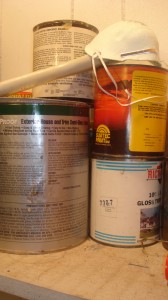
Spruce up your house with a fresh coat of paint.
The best time to paint the interior of a home is in the fall or spring. The cooler weather makes working both inside and out much more pleasant. Cooler weather also allows you to ventilate the rooms by opening up windows. When it comes to the job itself with so many paint choices, which one should you choose? Lead-based paints seem to have been eliminated from the US market, however, there are still other issues with paint that need addressing.
According to the Green Builders Coalition, all paint comes in three parts: pigment that gives it color; the binder, or resin, that makes the pigment stick when the paint is applied and forms a solid layer of paint; and the carrier, or solvent, that keeps the paint in liquid form and evaporates once the paint is exposed to air. All of these contain different chemicals. Other substances or chemicals may be added to paint to give it special characteristics, such as mold resistance or moisture resistance.
One additive besides lead that has received much attention recently is volatile organic compounds, or VOCs. Why are VOCs in paint in the first place? They are the “glue” that keeps the pigment and the binder or resin in a liquid solution long enough for the paint to be applied, then they conveniently evaporate so the paint can dry. Therefore, VOCs do serve a necessary function in paint.
Why is there a major concern over high-VOC paints? Like anything that produces high vapors, paints that have high-VOCs may cause or trigger respiratory problems. Consumers need to be aware that, although evaporation is greatest during and right after application, it may continue at lower levels for months. The emitted gases mix with the air in the room, exposing occupants to chemicals that can cause short- and long-term respiratory problems.
The solution is not to leave the house unpainted, but to find low- or no-VOC paints, which are now sold side-by-side with conventional high-VOC paints. Most home improvement stores carry these; consumers just have to do their homework. While there are no building code limitations on use of low-VOC paints, it is imperative that consumers find out more about the product before they select it. The EPA website, http://www.epa.gov/iaq/voc.html#Health_Effects, offers more information on VOCs in general. The National Association of Home Builders also has posted a guide consumers can use to select low-VOC paint on their website: http://www.toolbase.org/Technology-Inventory/Interior-Partitions-Ceilings/low-voc-paints.
Sprucing up your home can be very exciting and painting your home is a great way to express your individuality and ensure your home reflects your sense of style and personality. For more information on maintaining your home, visit the University of Florida/IFAS Extension publications website at http://edis.ifas.ufl.edu/topic_homes.
by Monica Brinkley | Sep 24, 2013
Normal
0
false
false
false
EN-US
X-NONE
X-NONE
/* Style Definitions */
table.MsoNormalTable
{mso-style-name:”Table Normal”;
mso-tstyle-rowband-size:0;
mso-tstyle-colband-size:0;
mso-style-noshow:yes;
mso-style-priority:99;
mso-style-parent:””;
mso-padding-alt:0in 5.4pt 0in 5.4pt;
mso-para-margin:0in;
mso-para-margin-bottom:.0001pt;
mso-pagination:widow-orphan;
font-size:11.0pt;
font-family:”Calibri”,”sans-serif”;
mso-ascii-font-family:Calibri;
mso-ascii-theme-font:minor-latin;
mso-hansi-font-family:Calibri;
mso-hansi-theme-font:minor-latin;}
Some children dread the thought of doing homework. They may leave an assignment for the last minute or refuse to do it all together. Many parents handle this by trying to force their children to do their homework. However, getting into a power struggle with your child is not effective. By having clear rules and expectations, you can create a positive situation for both you and your child.
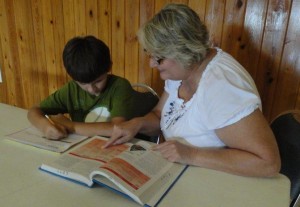
Help children develop good study habits
Meaningful homework can help students do better in school, especially as they get into the upper grades. Homework teaches children responsibility, as well as how to follow directions, manage time, begin and complete a task, work on their own, and practice what they’re learning in class. However, most children would much rather be playing or doing other things than homework. Many parents and children struggle over when, where, and how homework will be done.
At times, parents may feel that it would be easier just to do the work for their children. However, the National Parent and Teacher Association advises parents to let children do homework themselves. You may need to sit with elementary-school-age children and walk them through the process of how to study, help them organize the materials they need, and make sure they’ve completed all their tasks. As you do this, you are laying the foundation for good study habits.
Parents can offer to help check homework, but helping is very different from taking over. You also can reinforce good habits by helping your child find a regular place to work and a regular time of day to do homework. Instead of asking if your child has homework every night, always assume that there is homework, reading, or studying of some kind to be done.
Here are some tips on things you can do to help your children with homework:
- Have a set time for your child to do homework.
- Get the whole family involved by setting a regular family quiet time for working. Provide your child with a comfortable and well-lit place where they can do homework, such as a desk or a kitchen table with a chair. Minimize distractions by turning off the TV and making video games off-limits during quiet time.
- Make sure your child has pens, pencils, notebook paper, and any other supplies. Know where to direct your child to get information they may need, such as a school, a website, other children in the class, or a teacher’s help before or after school.
- Think of yourself as a coach to your children, providing assistance on what to do next if they get stuck, checking over their work when they are finished, or even helping them practice testing themselves on new skills. Showing interest in their work and encouraging their efforts can be a boost for your children and help them find greater success in school.
- Avoid constantly nagging or lecturing your child to do homework. If your child is continuously frustrated by or unable to complete assignments, visit your child’s teacher. Discuss ideas to work out possible strategies to help your child succeed.
For further information, go to EDIS.IFAS.UFL.EDU.
Sources: FAR1718 Helping Children with Homework, Heidi Liss Radunovich; FCS2203 Parenting During the Elementary School Years, Part 2: Discipline, Millie Ferrer-Chancy, Ingrid Rivera and Anne M. Fugate.






